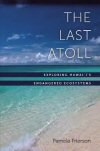SEJournal Online is the digital news magazine of the Society of Environmental Journalists. Learn more about SEJournal Online, including submission, subscription and advertising information.

BookShelf
The Last Atoll: Exploring Hawai’i’s Endangered Ecosystems
By Pamela Frierson
Trinity University Press, $16.95
Reviewed by ELIZA MURPHY
As a kid in Hawai’i, author Pamela Frierson knew of only eight islands that comprised her home state.
After later discovering islands and atolls strung further north, she embarked on a 10-year odyssey which put her face-to-face with marvelous and imperiled inhabitants eking out a bare bones existence in confined spaces scarred by human impacts. Frierson spent a decade living for months at a time with a menagerie of wildlife and a cast of characters devoted to protecting those fragile islands and their wild inhabitants.
Her book takes the reader to remote places where birds such as the Laysan albatross live over open water and touch down on land only when, according to Frierson, they are “herded by their hormones” to breed on “small spaces that could be refuges – or fatal traps.”
By all accounts, Polynesians were the first to arrive at this end of the archipelago. In a barrage of what paleoecologist David Steadman called a “triple whammy,” they decimated the place by “directly preying on birds that had no defenses against predators, introducing predators like the rat, and destroying habitat, all in the process of establishing their own transported landscape.”
Polynesians may have been the first marauders, but they weren’t the last. Guano miners, bird-feather poachers, turtle and seal hunters and fishermen all took their turn. One upside of the pillage of bird colonies was the Migratory Bird Treaty Act of 1918, the world’s first international treaty acknowledging that environmental conservation must transcend national boundaries.
Frierson debunks myths that islands exist independently of the large land masses, supporting the theory that islands do not exist in isolation.
“Islands are the proverbial canaries in the mine, microcosms where the forces that will shape our global future are already revealing themselves,” Frierson wrote.
Some island wildlife face unique threats. The endangered monk seal, for example, engages in rather rough sex, with mobs of randy males ganging up against a solitary female, a situation that can turn fatal. Attempts were made to move some repeat offenders.
Frierson shows biologists taking great care to do no harm. And she provides vivid evidence of the need to continue wrangling unwitting subjects without their informed consent to assess damage.
Neither the interconnectedness nor the isolation was lost on the military. Remote locales proved irresistible for secretive missions. Only a fraction of the military’s activities are known, but that didn’t interfere with Frierson’s determination to uncover its operations.
This book wrenches the heart with an all too familiar story of yet another exquisite place teeming with marvels too tempting for people to resist, a beguiling and pristine place that has been ransacked, exploited and plundered – another place on Earth where people ravaged the locals and introduced unwelcome dangers. Some problems, such as rats and invasive weeds, are eradicable. But others persist, such as the toxic residues left behind by the military. Some are still circulating through our closed planetary system in the flesh of birds.
“The Last Atoll” delights as it instructs. Frierson’s language is as beautiful as the places she describes and creatures that animate the text. Her intimate contact with the wildlife softens the numerous blows. She shares her luck at being among monk seals by sharing her glimpse of a pair who “seemed to be blowing bubbles into each other’s whiskers.”
This book offers a testament to the extraordinary people who forgo a life of leisure to secure protection for what remains of the wild world. And it makes a strong case for the world to adopt a “aloha ‘aina” – a traditional Hawaiian spiritual belief, a belief that caring for the land is a sacred trust. Frierson offers a prescription for healing our wounded world.
Eliza Murphy is an SEJ member and freelance writer based in Eugene, Ore.
* From the quarterly newsletter SEJournal, Summer 2013. Each new issue of SEJournal is available to members and subscribers only; find subscription information here or learn how to join SEJ. Past issues are archived for the public here.













 Advertisement
Advertisement 



